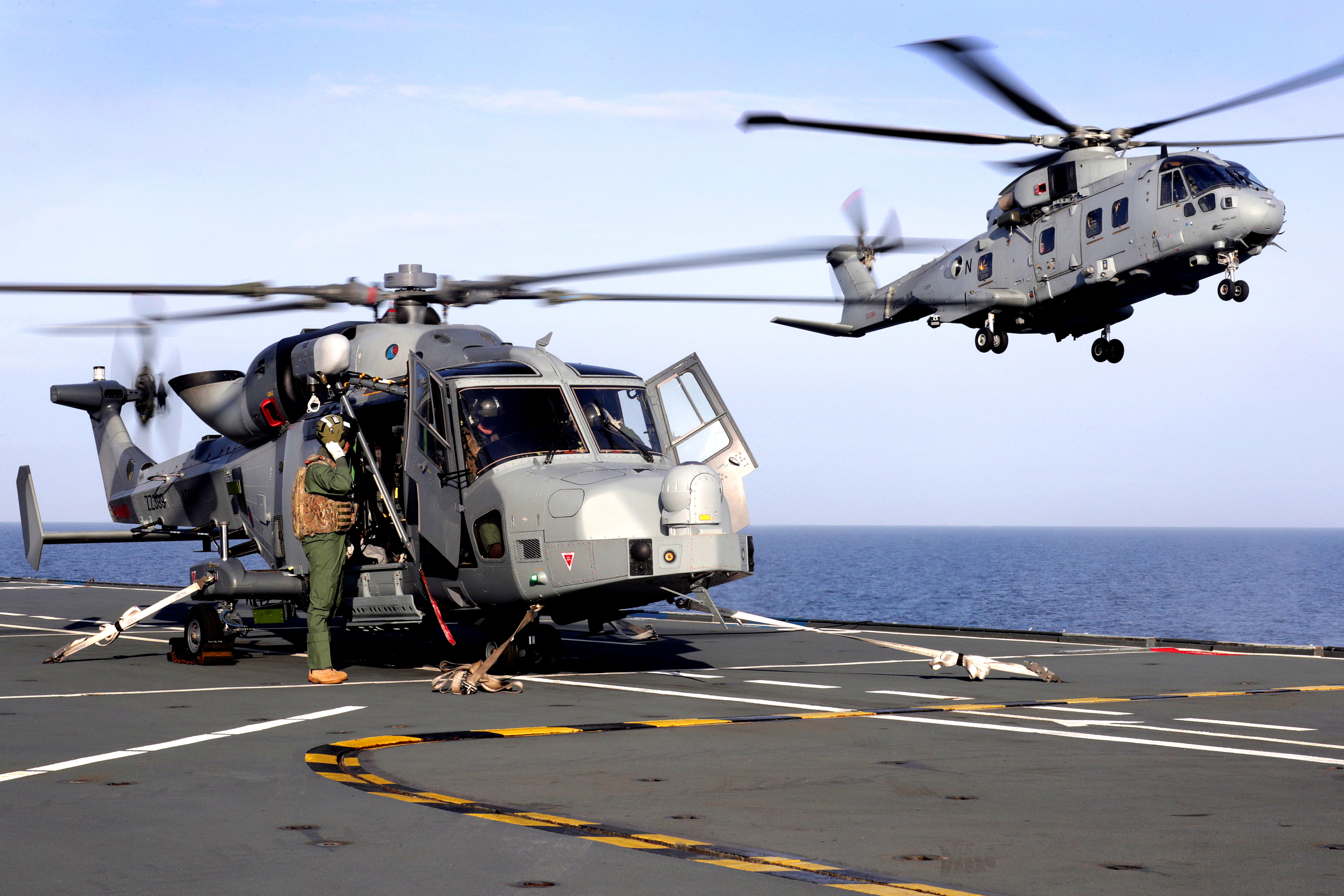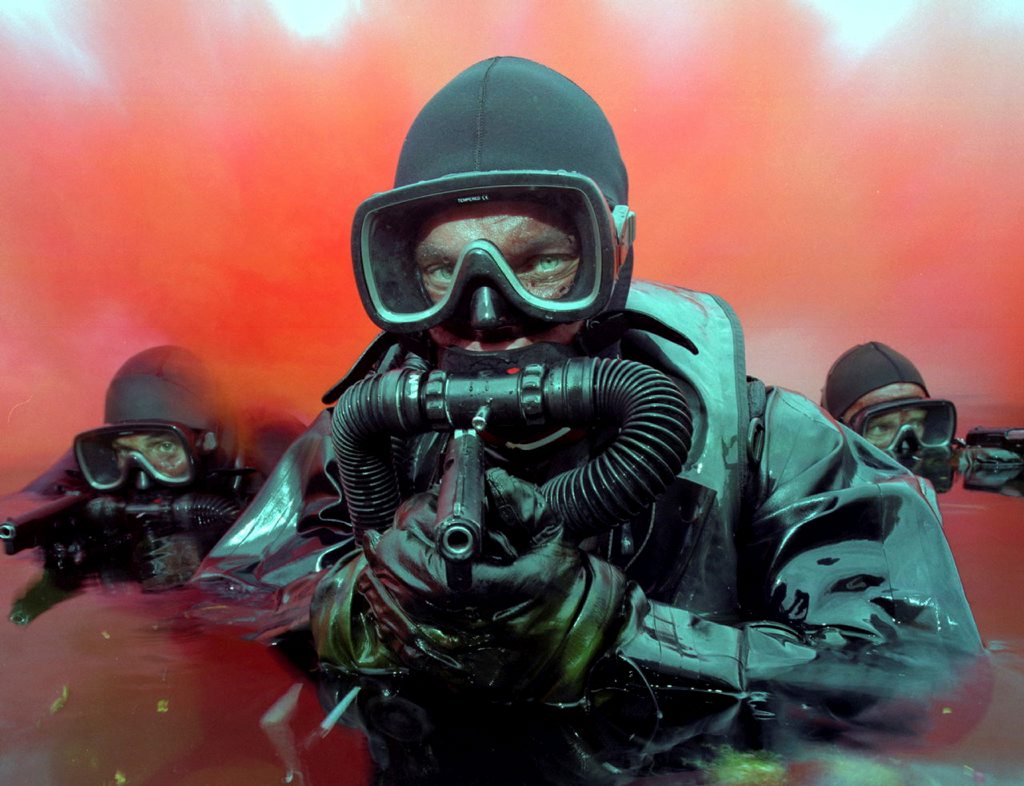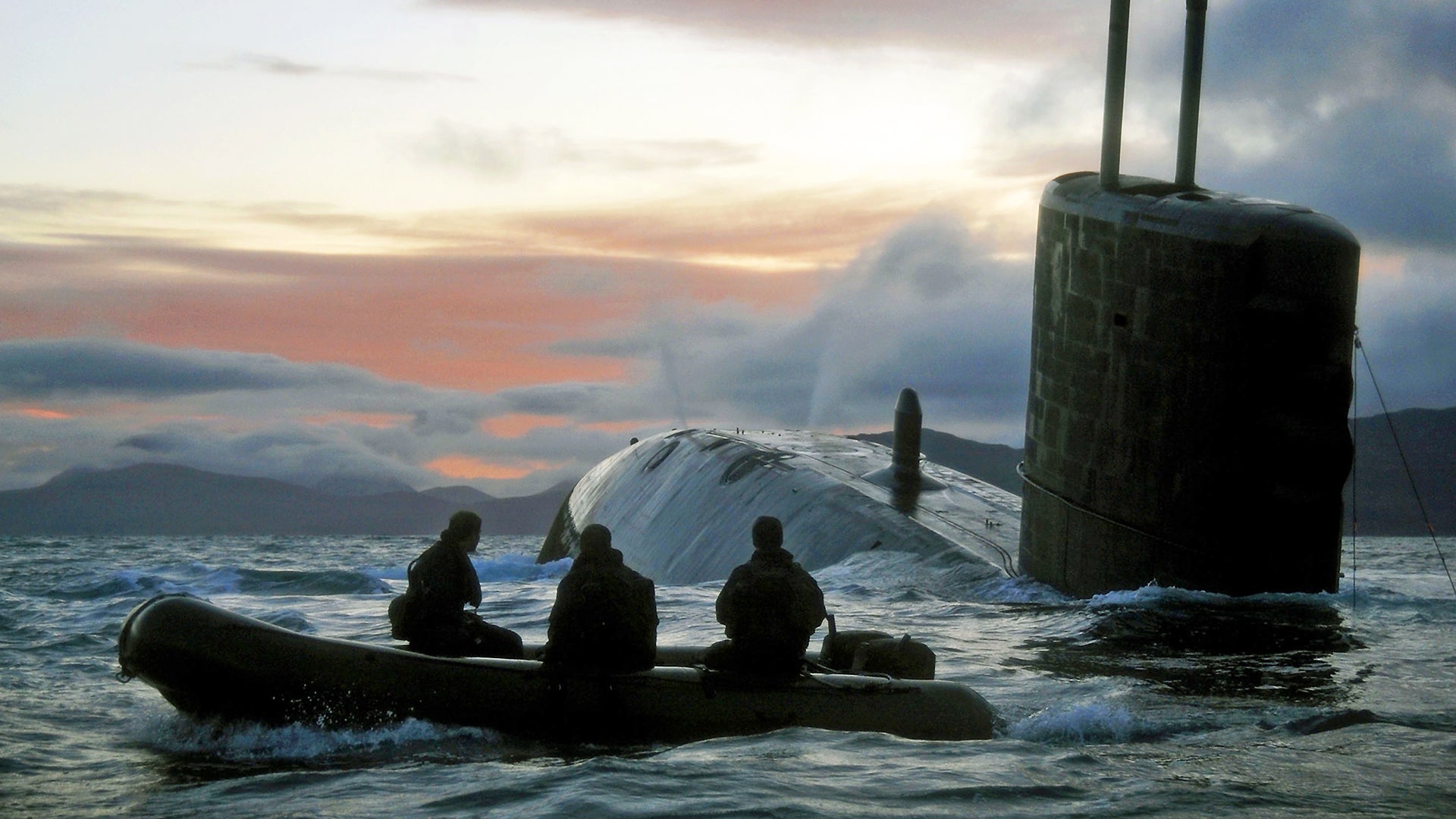British special forces sprung into action yesterday, storming a crude-oil tanker in the English Channel in response to a suspected hijack attempt that led to seven stowaways being detained after a raid that lasted just nine minutes. The secretive Special Boat Service (SBS), a less well-known component of the U.K. special operations community, but one with a storied history, carried out the raid.
Taking down the Nave Andromeda
The Special Boat Service team took control of the 42,000-gross-tonnage Liberian-registered tanker Nave Andromeda as darkness fell on the evening of October 25, 2020, after fast-roping from Royal Navy helicopters onto the deck. Reportedly landing at either end of the tanker in a pincer movement, the soldiers, equipped with night-vision devices, subdued the stowaways after they had made threats towards the crew during what had been a ten-hour standoff.
According to a report in The Times, the captain of the tanker put out the lights while Royal Navy helicopters used “obscurant” tactics — flashing lights in an effort to disorientate the stowaways on board.
Unconfirmed reports suggest that around 16 SBS operators may have been involved in the mission. A Royal Navy Type 23 frigate, HMS Richmond, was reportedly placed on standby nearby if backup was required.
The team from the SBS, based in Poole, Dorset, was apparently brought closer to the Nave Andromeda by a Royal Air Force (RAF) Chinook helicopter, which had been noted flying toward Poole earlier the same evening.
The SBS team was then transferred onto two troop-carrying Royal Navy Merlin helicopters and delivered to the ship, escorted by a pair of Royal Navy Wildcat helicopters. Both of these maritime rotorcraft types are based at Royal Naval Air Station (RNAS) Yeovilton, Somerset, in the west of England.

Yeovilton, home of the Commando Helicopter Force, keeps a handful of helicopters on a few hours’ notice for various missions, including supporting maritime counterterrorist (MCT) tasks in British waters. These typically might involve inserting assault teams from the SBS onto vessels, as was the case in the Nave Andromeda incident, or oil rigs.
“Armed Forces have gained control of the ship and seven individuals have been detained,” confirmed a statement from the Ministry of Defence, soon after the incident had been resolved. “Police investigations will now continue. Initial reports confirm the crew are safe and well.”
“I commend the hard work of the armed forces and police to protect lives and secure the ship,” said U.K. Defence Secretary Ben Wallace. “In dark skies, and worsening weather, we should all be grateful for our brave personnel. People are safe tonight thanks to their efforts.”

The Nave Andromeda had originally sailed from Lagos in Nigeria on October 6, 2020, and was headed to the English port of Southampton, where it was scheduled to arrive on October 25, and where it would then take on a cargo of petroleum. The ship’s owner, Greece-based Navios Tankers Management, said that the stowaways, all reportedly Nigerian, had “illegally boarded” the tanker while it was docked in Lagos. Two subsequent stops were made off the Canary Islands off the coast of North Africa and off the northern French coast.
However, the tanker didn’t arrive in Southampton as planned. Instead, with the vessel close to the Isle of Wight, off the south coast of England, its course started to become erratic, as evidenced by vessel tracking websites.
“Initially, it didn’t look like this was terrorist-related nor involving WMD [weapons of mass destruction], but the erratic behavior [of the ship] was concerning,” explained Tobias Ellwood, chairman of the Commons Defence Committee, the body appointed by the parliament to examine Ministry of Defence expenditure, administration, and policy. “The safety of the crew was important, as is indeed any unauthorized movement towards the coast,” he added.
With the 748-foot tanker around six miles off the coast of Bembridge, on the easternmost tip of the Isle of Wight — only around 60 miles east of the SBS base in Poole — local police were alerted to the situation when concerns were raised about the welfare of the 22 crew onboard the ship.
While the presence of the stowaways had been discovered during the tanker’s transit, they had apparently started to become violent when the crew tried to lock them in a cabin, reportedly after they expressed their desire to leave the vessel. Navios Tankers Management added that the police were informed on Sunday morning when the captain became “concerned for the safety of the crew due to the increasingly hostile behavior of the stowaways.”
By midday Sunday there was a three-mile exclusion zone around the tanker and a temporary restricted area in place over the vessel, prohibiting overflights below an altitude of 5,000 feet, to prevent any conflict with the police and Maritime and Coastguard Agency helicopters already operating around it. At this stage, there were no military helicopters on the scene and the U.K. Ministry of Defence confirmed it was not involved. However, a military response was by now clearly being prepared.
This year has seen a spike in migrants crossing the English Channel, with reports that 7,000 had arrived in the United Kingdom in small boats by the end of September, a more than threefold increase over the whole of 2019. While most of the vessels involved are far smaller than the Nave Andromeda, it’s a mission that is increasingly seeing involvement from the U.K. Armed Forces.
Early Sunday evening, with concerns for the tanker’s crew growing, police requested assistance from the U.K. Armed Forces and that’s when the Royal Navy’s elite Special Boat Service (SBS) immediately swung into action. The operation will have been formally authorized by both Defence Secretary Ben Wallace, and Home Secretary Priti Patel.
The tanker finally arrived in the port of Southampton on the following morning, October 26.

The Ministry of Defence maintains a very tight level of security around the work of the SBS and many of its operations remain classified. The Royal Navy’s website describes the unit very briefly as “Made up of small, highly trained teams, [specialized] in daring undercover raids that exploit the element of surprise.”
As the special forces unit of the Royal Navy, its tasks include, but are not restricted to, handling terrorist and other incidents at sea. While the number of members is a closely guarded secret, estimates suggest the SBS has around 200 to 250 personnel, most of them drawn from the Royal Marines Commandos, the Royal Navy’s amphibious light infantry.
Early days
The SBS traces its history back to World War II, and a number of British Armed Forces units that undertook raids, sabotage missions, and reconnaissance from small boats, canoes and submarines. Among these was the Special Boat Section, created in 1940 by Commando officer Captain Roger Courtney. The unit had particular success using folding canoes on raids against railways, port facilities, and airfields in Scandinavia and the Mediterranean. Later in the conflict, their activities would extend to Burma, for operations against the Japanese.
The wartime Special Boat Section also provided beach reconnaissance ahead of amphibious landings, including for landings in North Africa and Italy.
By early 1942, part of the Special Boat Section had been amalgamated with a similar unit, the British Army’s Small Scale Raiding Force, to create the new Special Boat Squadron.
Among the Special Boat Squadron’s notable activities were raids in the Aegean Sea, where they made use of adapted local fishing boats to operate unnoticed among the area’s shipping fleets. They also deployed teams from canoes, dinghies, and submarines. The latter method was used to deliver a team to Crete, where they blew up German aircraft and munitions before fighting their way out.

In early 1944, the Special Boat Squadron was renamed the Special Boat Service — the name it carries today — although it was disbanded after World War II. Reestablished in 1948 as the Special Boat Section, it underwent yet more name changes during the Cold War, becoming the Special Boat Company, the Special Boat Squadron, and finally the Special Boat Service in 1987. Meanwhile, its wartime activities took it to theaters including Palestine, Korea, and Indonesia.
On land and at sea
While maritime work is at the core of the SBS, the unit also operates on land if required and it has seen action on the ground in Northern Ireland and the Falklands and, more recently, has been engaged in Iraq and Afghanistan.
While there is no official word on the composition of the SBS, it’s assumed to include four squadrons each of around 64 soldiers. In the past, different squadrons were responsible for swimmer and canoe operations, operating small boats (including kayaks) and mini-submarines, plus maritime counter-terrorism and ship-boarding. Today, however, it is thought that these roles are rotated through the squadrons.
In addition to being flown into action aboard helicopters, the SBS also trains for “boat drop” operations, in which a Rigid Inflatable Boat (RIB) is delivered from the rear ramp of an RAF C-130J Hercules transport, followed by the SBS team, also descending under parachutes into the water below.
The SBS frogmen can also make use of the Dry Deck Shelter (DDS) that can be fitted to the Roal Navy’s Astute-class nuclear-powered fleet submarines. This allows an SBS team to be inserted or picked up close to a foreign shore. The DDS, combined with a Swimmer Delivery Vehicle (SDV) used to get from the submarine to the shore, allows the SBS to perform its covert infiltration activities almost anywhere around the globe where there is a coastline.
Befitting a special forces outfit, the SBS is known to be provided with a range of bespoke equipment, ranging from stealthy Fast Interceptor Craft (FIC) to, reportedly, Heckler & Koch P11 underwater pistols.
The SBS was at the forefront of U.K. special forces work in Operation Desert Storm in Iraq in 1991. Surveillance and sabotage teams from both the SBS, as well as elements of the British Army’s better-known Special Air Service (SAS) Regiment, were flown by RAF Chinook helicopters surveillance and sabotage teams deep behind Iraqi lines. Another Chinook reportedly flew an SBS team into Kuwait City to retake the British Embassy there.

In the wake of the terrorist attacks of September 11, 2001, the SBS found itself engaged in Afghanistan, where a contingent arrived at Bagram Airfield a month later. Again, they worked alongside their SAS counterparts and special forces helicopters from the RAF, including tracking al-Qaeda operatives across the country.
Later in the Afghan campaign, SBS teams formed part of the U.K. Special Forces Task Force at Kandahar Airport in southern Afghanistan, from where they targeted Taliban insurgents, flying into action onboard RAF, British Army, and Royal Navy helicopters.
British media outlets reported that two SBS operators took part in the planning for the 2011 raid on Osama Bin Laden’s compound in Abbottabad, Pakistan. Allegedly a captain and a major from the unit — possibly exchange staff officers — arrived at Bagram Air Base in Afghanistan to work on preparing for and briefing assault teams ahead of the mission.
Meanwhile, the incident off the coast of the Isle of Wight yesterday has parallels with a previous event that took place in British waters.

On the evening of December 21, 2018, stowaways seized the 71,000-gross-tonnage Italian cargo vessel Grande Tema in the Thames estuary, off the east of England. Once again, the military response involved an assault team from the SBS delivered by two Royal Navy Merlin HC4s, escorted by two Wildcat HMA2s. After the ship had been secured by the special forces team, it was brought into nearby Tilbury harbor in Essex where four stowaways were handed over to police.
The SBS is also expected to board vessels during military campaigns too, as was the case during the British campaign to retake the Falkland Islands in the South Atlantic following their invasion by Argentina in 1982. On May 9 that year, SBS soldiers were delivered by Sea King helicopters onto the Argentine intelligence-gathering vessel Narwal, a repurposed fishing trawler, after it had been attacked by Royal Navy Sea Harrier combat jets.
While the full story of most of their missions will perhaps never be told, incidents like the storming of the Nave Andromeda demonstrate that the UK’s special operations community is ready to fulfil these challenging missions at a moment’s notice.
Contact the author: thomas@thedrive.com
